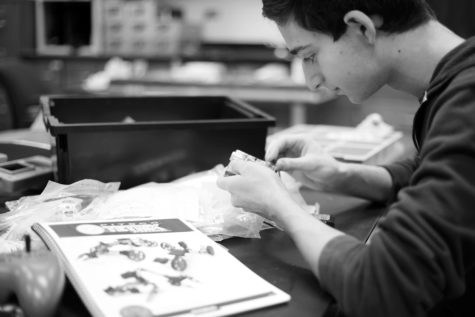Grants reward teacher innovation

In past years, math teacher Karen Fitzsimons overlooked the e-mail asking her to apply for a Teacher Innovation Grant, a sum of money awarded to teachers to help further student learning. This year, she and the Math Department had an idea of what to use the money for: e-Day, the celebration of the mathematical constant beginning with 2.718, on Feb. 7, 2018.
“Teachers have all these creative ideas, so [these grants are] a way to help these ideas come to fruition,” said Fitzsimons. “Leave it to our district to do something so cool like this, to provide great experiences for our students.”
According to Jim Shellard, director of development for the Glenbrook High School Foundation, a total of $5,000 in grant money was awarded on Oct. 26 to two Glenbrook North teachers and four Glenbrook South teachers. This year, four out of a total of 18 proposals were chosen. Three GBS teachers collaborated on one proposal, and the three other grants were awarded to individual teachers. The GBN teachers received a total of $2,800. Fitzsimons was given money to pay for the expenses of e-Day, and physics teacher Bob Froehlich, who is the sponsor of GADGET club, bought four robotics sets with the money. The Innovation Grants are awarded in the fall and the spring. Each season’s grants have a budget of $5,000 for a total of $10,000 per year.
The Glenbrook Foundation’s mission statement is “to obtain resources to enhance, enrich and expand access to programs for Glenbrook High School students.” The proposals that are determined to most clearly advance student learning and achievement are selected for the grant.
Fitzsimons said she and Maria Vasilopoulos, instructional supervisor for the Math Department, wrote and sent a proposal to the Glenbrook High School Foundation for the Teacher Innovation Grant program and were awarded $800 to help the department fund e-Day.
Shellard said all of the Foundation’s money is obtained through fundraising and donations. The criteria for selecting the winners of the grants was divided into six categories: student benefit and educational gains, number of students affected, creativity, ability to supplement an existing program, ability to stay within the budget and sustainability to continue after being awarded the grant.
Fitzsimons said she plans to use the money to purchase math games and activities for e-Day. Although she does not know what specific activities will be included, she wants the day to focus on mathematical concepts besides those only related to e.
“We’re hoping to buy … stuff [with the money from the grant] that students can use to explore everything from e to Pythagorean triples to all kinds of different things, such as exponential growth and logarithms,” Fitzsimons said.
In addition to Fitzsimons, Froehlich was awarded a $2,000 grant to buy four TETRIX robotics sets primarily for physics classes and GADGET, although all students are welcome to use them.
The robotics sets can be plugged into a computer and are programmed through Arduino, a coding tool, to perform a certain task, such as making a car move.
“My students in GADGET and AP Physics are already doing things with Arduino,” said Froehlich. “[The robotics sets] are microprocessors that you could program to do all kinds of stuff, and the TETRIX was based on Arduino.”
Senior Simon Hakimian, president of GADGET club, said he was excited when Froehlich received the grant because the robotics sets would benefit inexperienced members. Hakimian hopes the sets will allow club members to perform basic tasks through hands-on activities.
“The [robotics] sets use a block-based programming instead of making you have to type code for it, so it’s a lot easier to start off with when you want to … understand the basics of how to code,” Hakimian said.
Shellard said the Foundation aims to offer as many opportunities to students as possible.
“Sometimes due to budgetary constraints [and] sometimes due to interest levels, teachers may not have the opportunity to try and do something new and different or creative in the classroom,” said Shellard. “[The grants] give them another way to give students the resources to be able to learn beyond the classroom.”

